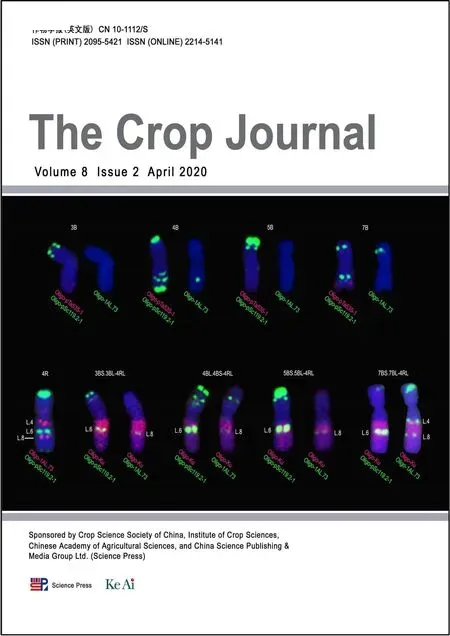Strip rotary tillage with subsoiling increases winter wheat yield by alleviating leaf senescence and increasing grain filling
Jinning He,Yu Shi,*, Junye Zho,b,Zhenwen YuNtionl Key Lbortory of Crop Biology, Agronomy College of Shndong Agriculturl University,Ti'n 271018,Shndong, Chin
bAgricultural Information Institute of Chinese Academy of Agricultural Sciences,Beijing 100081,China
A B S T R A C T
1.Introduction
The Huang-Huai-Hai Plain (3HP) is a high-yielding agricultural area often referred to as China's breadbasket. Over 60% of China's winter wheat (Triticum aestivum L.) is produced in this region [1]. However, intensive and continuous conventional tillage regimes have destroyed the structural stability and nutrient content of the soil in this area,thereby reducing winter wheat productivity[2].Before the 1990s,plowing tillage reduced the water storage capacity and nitrogen accumulation, thereby reducing energy use efficiency and economic benefit. After the 1990s, rotary tillage gradually replaced plowing tillage owing to its cost-effectiveness and shifted the tillage depth from 25 cm to 15 cm[3].However,compared to remediation of topsoil compaction, the remediation of subsoil compaction is more complex and expensive because of the need for rotary tillage and tractor wheels in the 0-15 cm soil layer and the subsequent use of machinery for seeding,chemical and fertilizer spreading, and harvesting [4]. This approach also causes hardpans to develop, limiting water absorption and root growth and ultimately reducing crop yields and agricultural sustainability. Optimizing tillage regimes could restore farmland ecosystems and result in sustainable cultivation practices.
Winter wheat yield potential is divided into three major components: spike number, kernel number, and kernel weight [5]. Grain filling is the key period of wheat growth in which the fertilized eggs develop into caryopses, and its rate and duration determine kernel weight. Leaf photosynthesis and senescence play vital roles in modulating grain-filling processes [6]. Photosynthetic assimilation during grain filling accounts for over 75% of wheat yield, and flag leaf photosynthesis contributes 30%-50% of grain filling assimilation in wheat [7,8]. Flag leaves are the last senescent leaf and can capture more light energy and are closer to the vascellum of spikes than lower leaves [9]. Latifmanesh et al. [10] showed that conservation tillage(i.e.,no tillage and subsoiling tillage)markedly increased flag leaf chlorophyll content and net photosynthetic rates and increased wheat yield.During grain filling, leaf photosynthesis gradually weakened as the leaves began to deteriorate and photosynthetic organs began to fail[11]. An important cause of leaf senescence is damage to the pericellular membrane by reactive oxygen species (ROS) or free radicals,thereby destroying normal cell metabolism[12].Plants have evolved advanced antioxidant defense systems that employ antioxidases and osmotic-adjustment substances to scavenge ROS or free radicals. These systems reduce the pernicious effects of ROS or free radicals on the pericellular membrane,thereby delaying leaf senescence[13].Cell proteins degrade and photosynthetic rates decrease during leaf senescence; however, carbon storage remobilization increases, thereby accelerating filling [14]. Strategies for increasing the photosynthetic rates of flag leaves and delaying the senescence process would promote high grain yield.
Tillage methods strongly influence soil traits and winter wheat growth[15].Deep plowing breaks dense soil layers and improves soil properties relative to shallow plowing but may transfer compaction to a deeper layer because of the effects of the plow pan [16]. Rotary tillage can reliably break down an argillaceous layer and reduce soil compaction; however, it greatly loosens topsoil, causing the soil to quickly lose moisture by evaporation. Wheat roots cannot maintain close contact with loose soil, impairing growth [17]. In contrast,conservation agriculture, which involves reduced tillage, notillage, and subsoiling, facilitates photosynthesis and wheat grain filling [18,19]. Still, completely removing all tillage does not consistently increase winter wheat yield[20].Eliminating tillage for long periods results in a positive effect for the first few years, but long-term reduction in tillage or lack of tillage increases soil bulk density and penetration resistance in the 10-20 cm soil layer, thereby reducing grain yield [21].Subsoiling is a method that loosens hardpan and breaks up deep, compacted soil layers without bringing the infertile subsoil to the top layer,and its effects can last up to four years[22,23].One study[24] has suggested that the physical effects of subsoiling usually last only 1-2 years,after which the plow pan reappears.
Thus, it is desirable to adopt a tillage regime that will improve productivity and preserve natural resources. The applicability of tillage regimes also should be locally assessed before their widespread application in any given region. To date, studies on interval subsoiling tillage regimes have focused on soil properties, nitrogen accumulation and transport,or dry matter accumulation[25-28].Little information is available about the effects of various tillage regimes, particularly strip rotary tillage with interval subsoiling, on leaf sucrose level, senescence, and grain filling. We conducted a field study based on a continuous 9-year tillage regime experiment to compare conventional tillage practices with a new combined tillage practice: strip rotary tillage with a 2-year subsoiling interval(STS),which combines the advantages of strip rotary tillage and subsoiling,in the 3HP of China.This study investigated the effects of various tillage regimes on grain filling in winter wheat,with the aim of determining how changes in sucrose and the senescence of flag leaves after anthesis under various tillage regimes influence grain filling.
2. Materials and methods
2.1. Experimental site
The study was initiated in 2007 in the village of Shijiawangzi,Yanzhou, Shandong province, northern China (35°40′N,116°41′E, 55 m above sea level). This village is located at the center of the 3HP and its environment is representative of the region. The area has a semi-humid continental monsoon climate with annual average temperature of 13.6 °C, annual cumulative sunshine hours of 2460.9 h, and groundwater depth of 25 m.The soil type of this village was a Haplic luvisol(FAO classification system). The soil has a pH of 7.6 and is composed of 29.6% clay, 37.3% silt, and 33.1% sand. The monthly precipitation in the winter wheat growing season from 2014 to 2016 and the mean annual precipitation during a 9-year period (2007-2016) at the experimental site are shown in Fig. S1. The local meteorological bureau of the Yanzhou district, located 0.5 km from the Shijiawangzi experimental site,provided these data.
2.2. Experimental design
The tillage study was conducted over 9 years. Data collected from 2014 to 2016 were analyzed. There were four tillage treatments: rotary tillage (RT), strip rotary tillage (ST), strip rotary tillage with a 2-year subsoiling interval (STS), and conventional plowing tillage (PT). In STS, subsoiling was performed in the winter wheat growing seasons of 2007-2008,2010-2011,and 2013-2014;ST was performed every season. Three complete cycles of 3-year rotations were followed in 2007-2016 (Table S1). The operational procedures for each tillage practice are shown in Table S2, and the equipment used for the practices is displayed in Fig. S2 and Table S3. All tillage treatments were replicated three times and followed a randomized block design. Each plot was 40 m× 4 m.
2.3. Crop management
The winter wheat cultivar‘Jimai 22'was selected,because it is one of the most widely planted commercial winter wheat cultivars in the 3HP of China. After corn harvest, the stalks were pulverized twice with the 1JH-180 straw-returning machine. The winter wheat planting details are listed in Table S4. For the wheat season, 105 kg N ha-1as urea, 150 kg P2O5ha-1as diammonium phosphate,and 150 kg K2O ha-1as potassium chloride were surface-applied to the soil at the sowing stage.At the jointing stage,135 kg N ha-1as urea was applied to the soil at a depth of 4 cm by ditching.In 2014-2015,the seeding quantities were 103 kg ha-1for RT and PT and 112 kg ha-1for ST and STS.The seedling density of RT,ST,STS,and PT were 186,183,184,and 187 plants m-2,respectively.In 2015-2016,the seeding quantities were 106 kg ha-1for RT and PT and 115 kg ha-1for ST and STS.The seedling density of RT,ST, STS, and PT were 184, 181, 182, and 186 plants m-2,respectively. At the three-leaf stage, seedling density was adjusted to 180 plants m-2in all treatments.
After winter wheat was harvested using the GE60 harvester,the straw was returned to the field.In the subsequent corn season, no-tillage was performed for corn planting.Irrigation and other agronomic management strategies were kept the same in all treatments, following local recommendations for high yields.
2.4. Sampling method and measurement
2.4.1. Root activity
Roots were collected manually from three independent areas within each experimental plot in 15-cm soil layers down to 45 cm at jointing, anthesis, and 20 days after the start of anthesis (DAA). Root activity was determined using the triphenyl tetrazolium chloride (TTC) method and was recorded as a measure of TTC reduction activity.
2.4.2. Radiation interception
Photosynthetically active radiation (PAR) was measured in each treatment with three replicates at 0, 14, and 28 DAA.These days represent critical stages for grain filling. PAR was measured at heights of 0, 20, 40, 60, and 80 cm above ground using a SunScan Canopy Analysis System (Delta-T Devices Ltd., Cambridge, UK) to determine the PAR capture ratio(PARcr), penetration ratio and reflection ratio, as described previously [11].
2.4.3. Chlorophyll content and leaf area index
To characterize leaf greenness, chlorophyll content (SPAD values) was measured using a portable CCM-200 Plus Chlorophyll Content Meter (Opti-Sciences Inc., NH, USA) from 40 representative flag leaves at 0, 7, 14, 21,and 28 DAA. The leaf areas of 40 plants in each treatment were determined using a leaf area meter (WinFOLIA Analysis System; Regent Instruments Inc.,Quebec,Canada),and the leaf area index(LAI)was calculated.
2.4.4.Net photosynthesis rate
Twenty flag leaves in each experimental plot were sampled at 7-day intervals from anthesis to maturity to obtain the rate of net CO2assimilation (net photosynthetic rate, Pn) using a CIRAS-2 Portable Photosynthesis System (PP-Systems,Hitchin, Herts, UK). The measurement was performed from 9:00 AM to 11:00 AM under natural light.
2.4.5.Dry matter accumulation
In each plot,all plants in a 1-m section of an inside row were cut manually at ground level to determine the aboveground dry matter accumulation at pre-wintering, revival, jointing,anthesis, and maturity and then oven-dried at 70 °C to constant weight[19].
2.4.6.Flag leaf sampling and biochemical assays
A random sample of 40 flag leaves from each experimental plot was collected at 7-day intervals from anthesis to 28 DAA.Fresh samples were immediately submerged in liquid nitrogen and then stored at-80°C until biochemical assays were performed.The whole flag leaf (including the leaf and veins) was used to determine the sucrose (SS) content, sucrose phosphate synthase(SPS)activity and antioxidant enzyme activities.
The SS content(mg g-1fresh weight[FW])and SPS activity(μmol sucrose g-1FW h-1) were determined as previously described [8]. Superoxide dismutase (SOD; U g-1FW) and soluble protein (SP; mg g-1FW) were measured as described previously[13].SOD activity was calculated spectrophotometrically according to inhibition of the photochemical reduction of nitroblue tetrazolium.SP concentrations were measured by the Coomassie Brilliant Blue method.Malondialdehyde(MDA)concentrations were assayed following Quan et al. [29] and expressed as nmol g-1FW.
2.4.7.Grain-filling traits
Emerging flowering spikes were all tagged on the same day,and 40 tagged spikes in each plot were sampled at 7-day intervals from the beginning of anthesis to maturity. The grain-filling rate was determined from the accumulation of dry weight. At each sampling date, kernels were separated from glumes and stalks, dried at 105 °C for 10 min, and then dried at 70 °C to constant weight, to determine grain dry weight.The total number of kernels was determined and their dry weights were recorded.
2.4.8.Grain yield and yield components
Grain yield was determined based on the 3 m2harvest areas(three replicates) in each plot and expressed at 12.5% grain water content.All spikes from the sampled area were counted to estimate spike number ha-1for each plot.Sixty ear-bearing culms from each plot were randomly selected to determine kernel number and kernel weight per spike. A subsample of 1000 kernels from the yield measurement sample, with three replicates,was used to calculate 1000-kernel weight.
2.5. Statistical analysis
Grain filling can be fitted by the following logistic function[5]:

where y(mg)is kernel weight;a(mg)is the upper asymptote of kernel weight; b and c are the coefficients determined by the curvature; and x (day)is grain-filling time.
The following equations were used to calculate the time required to reach maximum grain-filling rate (Tmax); the duration of grain filling (T), defined as the period when y was achieved at 99% of a; the grain weight at maximum grain filling rate (Wmax); maximum grain filling rate (Vmax);mean grain filling rate (Vmean); and active grain filling period (D), defined as the period when y was between 5%and 95% of a:
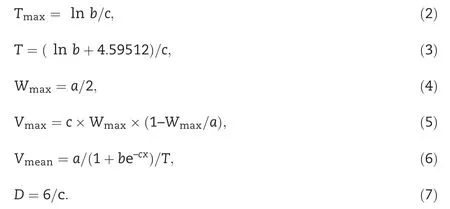
Data normality was determined by Shapiro-Wilk tests,and homogeneity of variances was evaluated by Levene's test. For the agronomical and physiological traits, yield components, and grain yield, differences among the four tillage practices were tested by analysis of variance(ANOVA;α = 0.05) followed by least significant difference tests. Twoway ANOVA was fitted to examine the main effects and interactions of tillage and growth seasons on grain yield and yield components in the 2014-2016 growing seasons. Significant differences between tillage treatments were examined using one-way ANOVA.Pearson's correlation tests were used to examine the possible relationships among the physiological traits,yield components and grain yield.SPSS 22.0(SPSS Inc., Chicago, IL, USA) was used for all analyses.
3. Results
3.1. Root TTC reduction activities
In the 0-15 cm layer, the root activities for RT and ST were greater than those for STS and PT at jointing and anthesis(Table 1). However, at 20 DAA, the root activities did not differ among RT, ST, and STS but were higher than those in response to PT. In the 15-30 cm layer, the root activities did not differ between STS and PT but were significantly higher for STS than for RT and ST at the three growth stages.In the 30-45 cm layer, STS showed the highest root activities,whereas the root activities for RT, ST, and PT did not differ at jointing, anthesis, and 20 DAA.
Values followed by different letters within the same column are significantly different at P <0.05.

Table 1-Root TTC reduction activities of winter wheat under various tillage practices at jointing, anthesis, and 20 days after anthesis in the 2014-2015 growing seasons.
3.2. Radiation interception
In 2014-2015, the PAR capture ratio in the winter wheat canopy under STS was 92%, which was higher by 4.7% and 10.8% than that under PT and RT. The lowest PAR value was obtained in ST (Fig. 1). However, an opposite pattern was detected in the PAR penetration ratio.The PAR reflection ratio did not differ between treatments. The results for 2015-2016 were similar to those for 2014-2015.
At 0 and 14 DAA, STS and PT showed the highest PAR capture ratios at a height of 0 cm, followed by RT and finally ST at the same height(Fig.2).At heights of 20,40,and 60 cm,the highest PAR capture ratios were obtained in STS,followed by PT and then RT, with ST having the lowest PAR capture ratio.At 28 DAA,the PAR capture ratios at heights of 0,20,40,and 60 cm in STS were the highest, followed by PT and RT,whereas the lowest value was obtained in ST.
3.3. Chlorophyll SPAD value, leaf area index, and photosynthetic rate
In 2014-2015, SPAD was not significantly different among treatments from 0 to 7 DAA(Fig.3-a).PT was higher than RT and ST, but lower than STS from 14 to 28 DAA. No significant differences were observed between RT and ST at 14 and 28 DAA. However, RT was markedly higher than ST at 21 DAA. In 2015-2016, no significant differences were observed among all treatments at 0 DAA(Fig.3-b).At 7 DAA,SPAD did not differ between PT and STS,but was higher for those treatments than for RT and ST. From 14 to 28 DAA,SPAD was highest for STS, followed by PT and RT, with ST showing the lowest SPAD.
With grain filling, LAI continued to decrease (Fig. 3-c). In 2014-2015, PT and STS were higher than RT and ST at 0 DAA.From 7 to 28 DAA,the LAI was highest in STS,followed by PT;lower LAI values were obtained in RT and ST, and the differences among the treatments were markedly different.STS increased the mean LAI by 6.5%, 15.9%, and 20.6% in PT,RT,and ST,respectively.The results in 2015-2016 were similar to those in 2014-2015(Fig.3-d).

Fig.1- Photosynthetically active radiation(PAR)capture ratio, penetration ratio,and reflection ratio in winter wheat canopy under various tillage practices after anthesis in the 2014-2016 growing seasons.RT,rotary tillage;ST,strip rotary tillage;STS,strip rotary tillage after subsoiling;PT,plowing tillage.Error bars represent standard error of the mean.Different letters indicate significant differences between treatments(P <0.05).
In both growing seasons, no significant differences were observed in Pnof flag leaves after anthesis among all treatments at 0 and 7 DAA (Fig. 4). Pnwas highest from 7 to 28 DAA in STS,followed by PT and then RT;ST had the lowest Pn.Relative to PT,RT,and ST,the mean Pnvalues increased by 8.7%, 16.8%, and 19.6% in STS in 2014-2015 and 6.6%, 12.9%,and 18.0% in STS in 2015-2016, respectively. Pnlevels in the flag leaves after anthesis under STS were higher than those under other tillage practices.
3.4. Dynamics of dry matter accumulation
In both 2014-2015 and 2015-2016 seasons, dry matter accumulation did not differ among treatments before jointing(Table 2). STS and PT were higher than RT and ST at the jointing and anthesis stages. However, at maturity, the highest dry matter accumulation was observed in STS,followed by PT.The lowest levels were observed in RT and ST.
3.5. SS content and SPS activity
During the grain-filling stage,SS content and SPS activity first increased and then decreased,reaching peak values at 14 and 7 DAA, respectively (Fig. 5). In 2014-2015, the SS contents for PT and STS were dramatically higher than those for RT and ST at 0 DAA. From 7 to 28 DAA, STS showed higher SS content compared with the other treatments, with PT showing the second highest SS value. The results for SPS activity were similar to those for SS content, but SPS activity at 0 DAA did not differ significantly among the treatments. In 2015-2016,no significant difference in SS content was observed among the treatments.SPS activity did not differ among PT,STS,and RT and was higher in these groups than in ST at 0 DAA.From 7 to 28 DAA, the highest SS content and SPS activity were recorded in STS, followed by PT, whereas the lowest values were recorded in RT and ST.
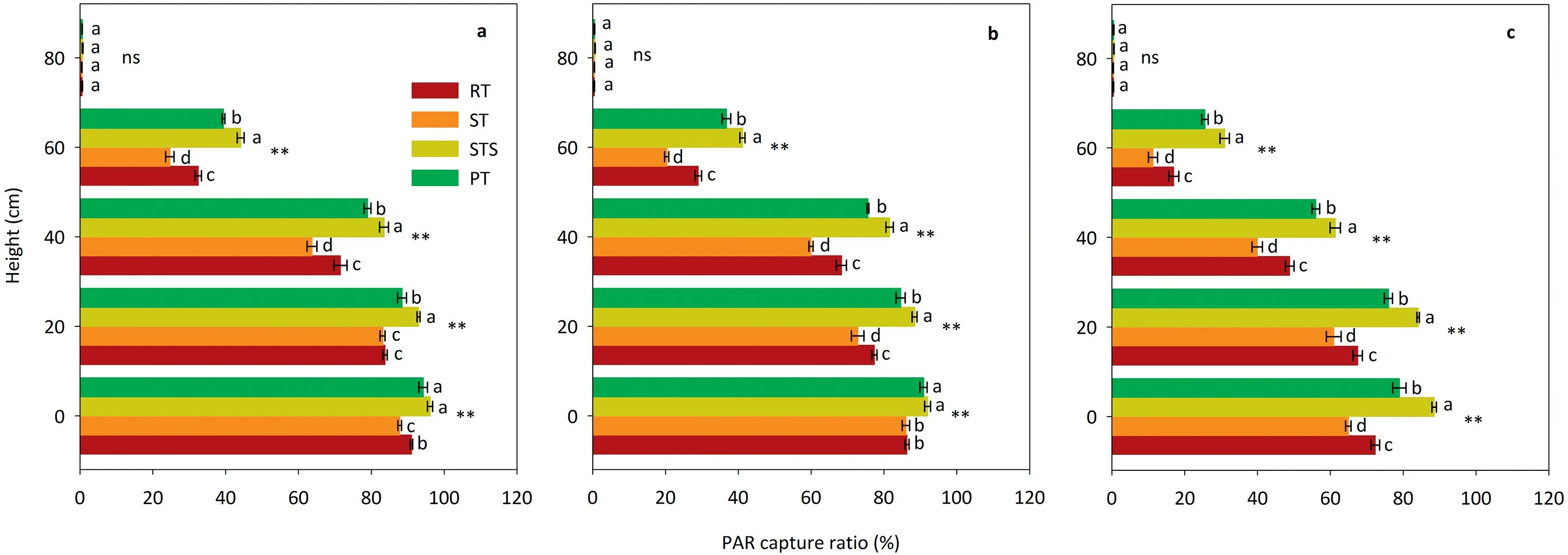
Fig.2-Photosynthetically active radiation(PAR)capture ratio of winter wheat canopy according to plant height,under various tillage practices at 0(a),14(b),and 28(c)days after anthesis in the 2014-2015 growing seasons.RT,rotary tillage;ST,strip rotary tillage;STS,strip rotary tillage after subsoiling;PT,plowing tillage.Error bars represent standard error of the mean.Different letters indicate significant differences between treatments(P <0.05).
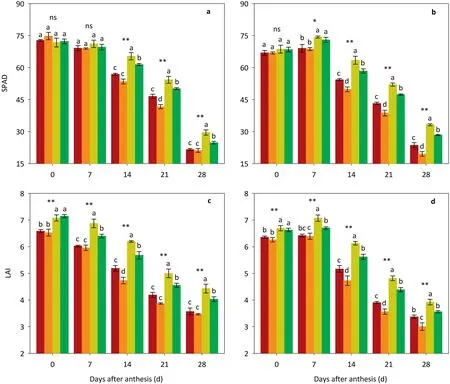
Fig.3-Chlorophyll SPAD value and leaf area index(LAI)of winter wheat under various tillage practices, after anthesis in the 2014-2015(a and c)and 2015-2016(b and d)growing seasons.RT,rotary tillage;ST,strip rotary tillage;STS,strip rotary tillage after subsoiling;PT,plowing tillage.Error bars represent standard error of the mean.Different letters indicate significant differences between treatments(P <0.05).
3.6. SOD activity and SP and MDA concentrations
The flag leaves from all tillage treatments showed similar trends in SOD activity, SP and MDA concentrations during grain filling in both 2014-2015 and 2015-2016 (Fig. 6, Fig. 7).SOD activity and SP concentrations were higher in PT and STS than in RT and ST at the beginning of grain filling. However,after 14 DAA, the highest SOD activity and SP contents were observed in STS, followed by PT, and the lowest levels were observed in RT and ST. In contrast, no significant differences in MDA concentrations among treatments were observed at 0 and 7 DAA in either growing season. From 14 to 28 DAA, STS showed dramatically decreased MDA contents in the flag leaves. Relative to PT, RT, and ST, the mean MDA contents of STS decreased by respectively 13.5%, 23.2%, and 34.3% in 2014-2015 and by 16.7%, 24.5%,and 35.5% in 2015-2016.
3.7. Grain-filling traits, yield components, and grain yield
In 2014-2015,PT and STS resulted in considerably higher grain weights than RT and ST at 7 DAA(Fig.8-a).From 14 to 28 DAA,the grain weight of PT was lower than that of STS but higher than those of RT and ST. ST showed the lowest value.Although the grain weight after anthesis was higher in 2015-2016 than in 2014-2015, similar responses of grain weight to tillage practices were observed(Fig.8-b).
At 7 DAA,the grain-filling rate did not differ between PT and STS and was higher in these groups than in RT and ST at 7 DAA in 2014-2015 (Fig. 8-c). However, in 2015-2016, the grain-filling rate of PT was lower than that of STS but higher than those of RT and ST(Fig.8-d).From 14 to 28 DAA,the highest grain-filling rate was observed in STS, followed by PT, whereas the lowest rates were observed in RT and ST in both growing seasons.
The grain-filling processes in all tillage treatments were fitted to the logistic growth curve equations (Table 3). In 2014-2015, Tmaxdid not differ among treatments. However,Wmax, Vmax, and Vmeanwere highest in STS, followed by PT and then RT, and were lowest in ST. The active grain-filling period(D)in PT and STS increased in comparison with RT and ST. In 2015-2016, PT and RT were higher than ST, but lower than STS, and there were no significant differences between PT and RT in Vmax. Differences in Tmax, Wmax, Vmean, and D under each treatment in 2015-2016 were similar to those observed in 2014-2015.
Tillage practices × growth seasons showed no significant interactive effects on grain yield and yield components(Table 4).Tillage practice showed no significant influence on kernel number. However, grain yield, spike number, 1000-kernel weight,and grain weight per spike differed significantly between the tillage treatments. The highest grain yield, spike number,1000-kernel weight,and grain weight per spike were observed in STS; PT showed the second greatest values and RT and ST showed the lowest.No significant differences in kernel number among treatments were observed in either growing season.Compared with STS,mean grain yields were lower by 11.2%(PT),15.4%(RT),and 18.0%(ST).Spike numbers decreased by 1.7%(PT),6.4% (RT), and 8.3% (ST). Grain weights per spike decreased by 6.2%(PT),8.5%(RT),and 9.6%(ST).

Fig.4-Net photosynthesis rate(Pn)in winter wheat flag leaves under various tillage practices after anthesis in the 2014-2015(a) and 2015-2016(b)growing seasons. RT,rotary tillage;ST,strip rotary tillage;STS,strip rotary tillage after subsoiling;PT,plowing tillage. Error bars represent standard error of the mean.Different letters indicate significant differences between treatments(P <0.05).

Table 2-Dry matter accumulation of winter wheat under various tillage practices in the 2014-2015 and 2015-2016 growing seasons.
4. Discussion
Intensive tillage adversely affects the soil structure and causes excessive decomposition of aggregates, thereby increasing the potential for soil erosion [30]. Suitable tillage practices can markedly improve soil environment and reduce soil compaction, thereby affecting root growth and spatial distribution. Our study showed that STS tillage practices resulted in positive shifts in the soil physical structure.Specifically, STS was characterized by a distinctly decreased soil bulk density and increased soil porosity in the 15-45 cm soil layer. A strong root system could increase the root anchorage and absorptive capacity for water and nutrients,thereby leading to high yields and resistance to root lodging[31].In this study,STS promoted root TTC reduction activities in the 15-45 cm layer at jointing, anthesis, and 20 DAA. Such promotion is beneficial for absorption and utilization of soil moisture and nutrients by wheat roots. Thus, growth and development of wheat are promoted.

Fig.5- Sucrose content and sucrose phosphate synthase(SPS)activity in winter wheat flag leaves under various tillage practices after anthesis in the 2014-2015(a and c)and 2015-2016(b and d)growing seasons.RT,rotary tillage;ST,strip rotary tillage;STS,strip rotary tillage after subsoiling;PT,plowing tillage.Error bars represent standard error of the mean.Different letters indicate significant differences between treatments(P <0.05).
The leaves are the main plant part through which wheat receives light energy and performs photosynthesis, and LAI directly affects the amount of intercepted PAR and the energy transformation capacity of the canopy [11]. Wang et al. [32]reported that the PAR capture ratio under no tillage was 163 μmol m-2s-1higher than that under plowing tillage, with the maximum difference observed at early filling. Similarly, we found that the LAI decreased after anthesis; however, the highest LAI was observed in STS from 7 to 28 DAA. Moreover,the PAR capture ratio in STS was higher than those in PT,RT,and ST,particularly for wheat with heights of 20-60 cm at later filling stages. Because chlorophyll plays an essential role in photon absorption, transmission and transportation and is closely associated with photosynthetic capacity in the leaves, chlorophyll content provides a better estimate of potential yield [33].Compared with PT, zero tillage and subsoiling tillage increased the chlorophyll content and photosynthetic rates at the late filling stage of winter wheat [34]. However, other findings [10]showed increased photosynthetic rates under conventional plowing tillage compared with that under no tillage. In this study,we found that STS markedly raised leaf chlorophyll SPAD values,postponed the decrease in the amount of leaf chlorophyll and ultimately contributed to an improvement in Pnafter 14 DAA, thereby resulting in greater photosynthetic assimilation capacity and increased dry matter accumulation. Furthermore,positive correlations between grain yield and PARcr, Pn, SPAD,and LAI were observed(Table 5).This indicated that STS created a favorable wheat canopy structure, increasing photosynthetic capacity after the middle grain filling stages.
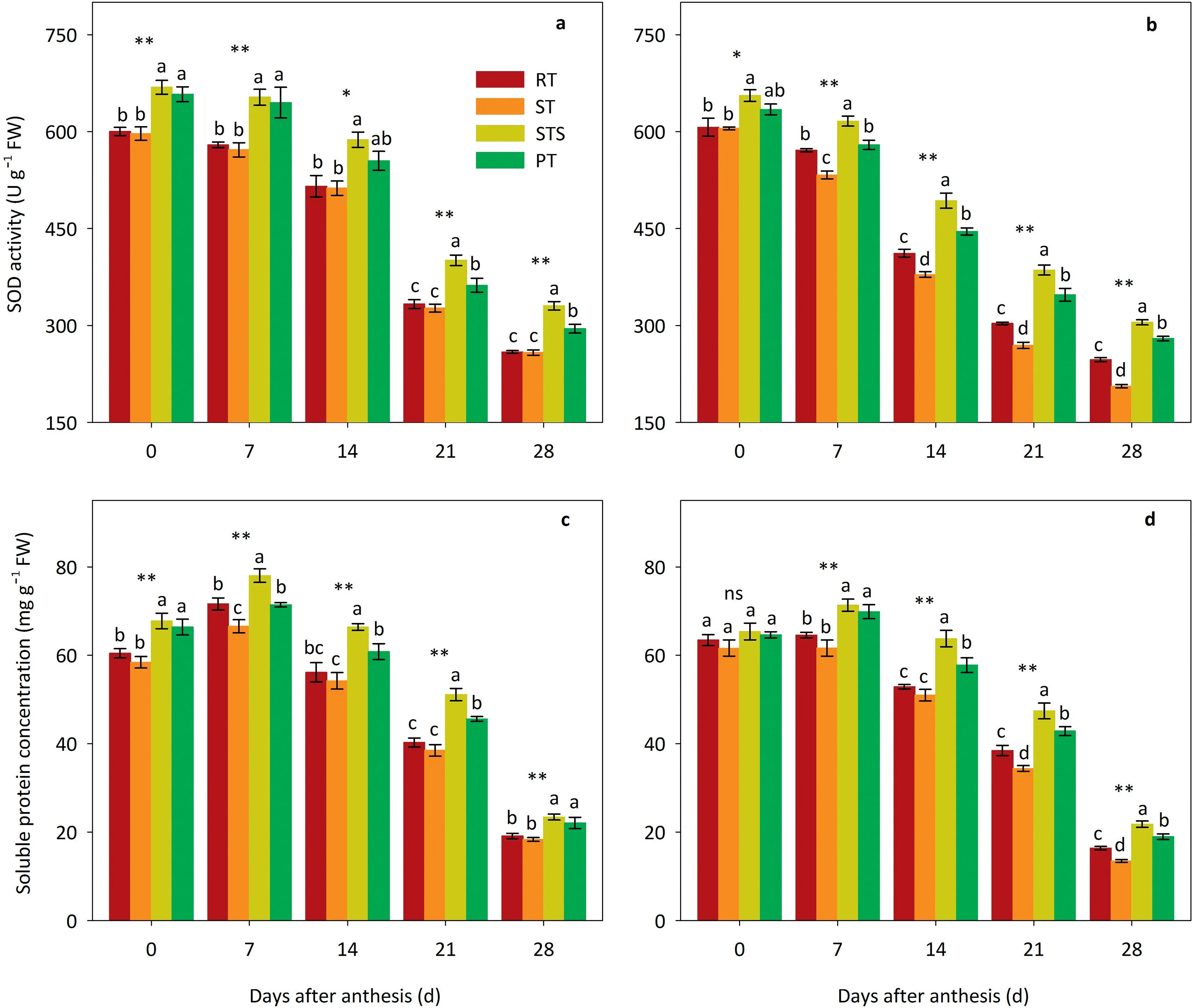
Fig.6-Superoxide dismutase(SOD)activity and soluble protein(SP)concentrations in winter wheat flag leaves under various tillage practices after anthesis in the 2014-2015(a and c)and 2015-2016(b and d)growing seasons.RT,rotary tillage;ST,strip rotary tillage;STS,strip rotary tillage after subsoiling;PT,plowing tillage.Error bars represent standard error of the mean.Different letters indicate significant differences between treatments(P <0.05).
Sucrose is the main photosynthate in wheat leaves and is essential for increasing yields.When the output of photosynthate is blocked, large amounts of sucrose accumulate in leaves, up to 7% of the dry matter weight [35]. SPS catalyzes the combination of uridine diphosphate glucose and fructose-6-phosphate to form sucrose-6-phosphate, a key enzyme in sucrose synthesis [36]. Soil conditions, such as soil moisture,soil fertility and soil texture, play important regulatory roles in wheat sucrose production [37]. Appropriate tillage regimes improve soil structure and increase the decomposition and disintegration of aggregates, thereby promoting soil contact and wheat growth[28].In our study,the highest SS content of the flag leaves was obtained for STS from 7 to 28 DAA,because SPS activity was greater in STS than in other treatments.This result showed the same growth trends as the grain filling rate during this time. SS content and SPS activity in flag leaves showed significant positive correlations with grain yield(Table 5). These results indicate that STS promoted the accumulation of sucrose after anthesis, favoring increased grain yield.
Longer functional photosynthesis with postponed leaf senescence could result in greater accumulation of photosynthates for grain filling and ultimately lead to greater wheat yields[38,39].The main factor inducing leaf senescence is ROS or free radicals, which disrupt normal cell metabolism by damaging the extracellular membranes and oxidizing lipids,proteins, and nucleic acids. However, wheat has effective antioxidases(such as SOD,peroxide dismutase,and catalase),which regulate oxidation processes and protect the cell against oxidative damage [5]. These antioxidase activities directly influence carbon assimilation in wheat flag leaves[40].In our study,SOD activities and SP concentrations in flag leaves were positively correlated with Pnand the MDA concentrations were distinctly negatively correlated with Pn(Table 5).Tillage influences affects soil moisture and nutrient status, which in turn influence the aging process of wheat plants.Huang et al.[41]reported that no-tillage and subsoiling increased SOD and peroxide dismutase activities and SP content, reduced the MDA and O2·-content in the flag leaves,and postponed leaf senescence under dry farming. In the present study, STS resulted in the highest SOD activities and SP concentrations and the lowest MDA concentrations in the flag leaves from 14 to 28 DAA, possibly because of the improvement in chlorophyll content and photosynthetic capacity. Moreover, grain yield was positively correlated with SOD activity and SP concentration in the flag leaves and negatively correlated with MDA concentration (Table 5). The combined tillage practices of STS could reduce flag leaf senescence and maintain greater photosynthetic performance. The premature senescence of wheat due to soil compaction under inappropriate tillage was the primary factor causing weak leaf activity and yield reduction.
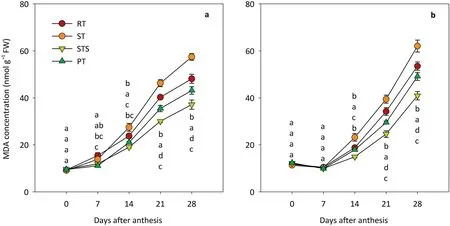
Fig.7-Malondialdehyde(MDA)concentrations in winter wheat flag leaves under various tillage practices after anthesis in the 2014-2015(a) and 2015-2016(b) growing seasons.RT, rotary tillage;ST,strip rotary tillage; STS,strip rotary tillage after subsoiling;PT,plowing tillage.Error bars represent standard error of the mean.Different letters indicate significant differences between treatments(P <0.05).
Grain weight is determined by grain filling rate and period[42]. Compared with rotary tillage, subsoiling significantly promoted grain-filling rate and Vmaxand Vmeanin the middle and late filling stages, and ultimately increased 1000-kernel weight[43].Similar results were observed by Liu et al.[6].The finding that STS not only increased Vmaxand Vmeanbut also prolonged the active grain-filling period (D) relative to the other treatments could explain the greater grain weight in STS(Table 3, Fig. 8). These benefits may have resulted from increased photosynthetic capacity and postponement of leaf senescence,given that PARcr,Pn,SPAD,LAI,SS,SPS,SOD,and SP were positively correlated with Wmax, Vmax, Vmean, and D,and MDA was significantly negatively correlated with Wmax,Vmax, Vmean, and D (Table 6). STS also showed the highest spike number, possibly owing to the increase of wheat population. Ultimately, STS optimized grain weight, spike number, and grain yield. STS appears to be a suitable tillage regime for wheat production in the 3HP by virtue of increasing grain filling by increasing photosynthetic capacity, and reducing premature senescence of flag leaves, thereby resulting in higher grain yield.
5. Conclusions
STS treatment was associated with a more favorable soil environment for wheat root growth and grain filling than other tillage practices, favoring higher wheat yields. Pnand PAR capture ratio were higher under STS, mainly because of the marked increase in SPAD values and LAI after anthesis.These increases promoted dry matter accumulation, sucrose production,and SPS activity in flag leaves.STS promoted SOD activity and SP content in flag leaves and reduced MDA concentrations after the middle grain filling stages,alleviating ROS damage and delaying the premature senescence of leaves and thereby increasing wheat grain filling and grain weight.To our knowledge,this is the first study to show the beneficial effects of strip rotary tillage with interval subsoiling on leaf sucrose, leaf senescence, and grain filling. Thus, the STS regime may be a step toward sustainable productivity of farmland in the 3HP of China.

Fig.8-Grain weight and grain filling rate under various tillage practices after anthesis in the 2014-2015(a and c)and 2015-2016(b and d)growing seasons.RT,rotary tillage;ST,strip rotary tillage;STS,strip rotary tillage after subsoiling;PT,plowing tillage.Error bars represent standard error of the mean.Different letters indicate significant differences between treatments(P <0.05).

Table 3-The grain-filling process model and grain-filling parameters used in this study for winter wheat grown in China.
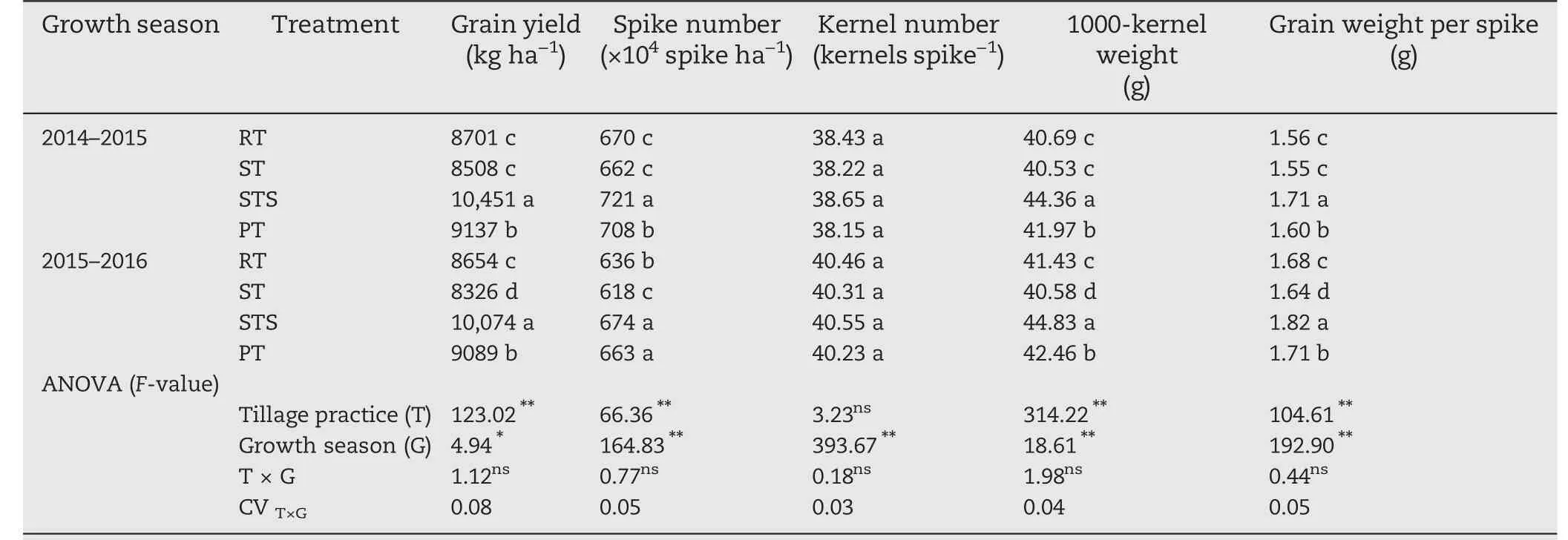
Table 4-Grain yield and yield components of winter wheat under various tillage practices in the 2014-2015 and 2015-2016 growing seasons.

Table 5-Pearson correlation coefficients among grain yield and physiological traits from 2014 to 2016 growing seasons.
AcknowledgmentsThis study was supported by the National Natural Science Foundation of China (31771715, 31401334, and 31601234) and China Agriculture Research System(CARS-3-1-19).Appendix A. Supplementary data Supplementary data for this article can be found online at https://doi.org/10.1016/j.cj.2019.08.007.
Table 6-Pearson correlation coefficients of grain yield and physiological traits with Wmax, Vmax, Vmean, and D of winter wheat.
PARcr, photosynthetically active radiation capture ratio; Pn, net photosynthesis rate; SPAD, chlorophyll SPAD value; LAI, leaf area index; SS,sucrose content; SPS, sucrose phosphate synthase activity; SOD, superoxide dismutase activity; SP, soluble protein concentration; MDA,malondialdehyde concentration; GY, grain yield; Wmax, weight of maximum grain filling rate; Vmax, maximum grain filling rate; Vmean, mean grain filling rate; D,active grain filling period.
* Significant differences at the 0.01 probability level.
** Significant differences at the 0.05 probability level.
PARcr Pn SPAD LAI SS SPS SOD SP MDA GY Wmax 0.99** 0.92** 0.91** 0.95** 0.82** 0.89** 0.76* 0.88** -0.98** 0.93**Vmax 0.89** 0.79** 0.80** 0.90** 0.83** 0.85** 0.74* 0.86** -0.89** 0.94**Vmean 0.97** 0.93** 0.85** 0.92** 0.78** 0.85** 0.70* 0.84** -0.97** 0.94**D 0.91** 0.86** 0.84** 0.81** 0.65* 0.76* 0.63* 0.73* -0.88** 0.74*
[19] Y.Shi,Z.W.Yu,J.G.Man,S.Y.Ma,Y.L.Zhang,Tillage practices affect dry matter accumulation and grain yield in winter wheat in the North China Plain,Soil Till.Res.160(2016)73-81.
[20] D.TerAvest,L.Carpenter-Boggs,C.Thierfelder,J.P.Reganold,Crop production and soil water management in conservation agriculture, no-till, and conventional tillage systems in Malawi,Agric. Ecosyst.Environ.212 (2015) 285-296.
[21] V.?íp,R.Vavera,J.Chrpova,H.Kusa,P.Ruzek,Winter wheat yield and quality related to tillage practice: input level and environmental conditions, Soil Till. Res. 132 (2013) 77-85.
[22] J.He,H.W.Li,X.Y.Wang,A.D.McHugh,W.Y.Li,H.W.Gao,N.J.Kuhn, The adoption of annual subsoiling as conservation tillage in dryland maize and wheat cultivation in northern China, Soil Till. Res. 94(2007) 493-502.
[23] K. Singh, O.P. Choudhary, H. Singh, Effects of sub-soiling on sugarcane productivity and soil properties, J.Sugarcane Res.2 (2013) 32-36.
[24] S.Tessier,B.Lachance,C.Lagu?,Y.Chen,L.Chi,D.Bachand,Soil compaction reduction with a modified one-way disker,Soil Till. Res. 42(1997) 63-77.
[25] S.Y. Ma, Z.W. Yu, Y. Shi, Z.Q. Gao, L.P. Luo,P.F. Chu,Z.J.Guo,Soil water use,grain yield and water use efficiency of winter wheat in a long-term study of tillage practices and supplemental irrigation on the North China Plain, Agric, Water Manage. 150 (2015) 9-17.
[26] H.G. Wang, Z.J. Guo, Y. Shi, Y.L. Zhang, Z.W. Yu, Impact of tillage practices on nitrogen accumulation and translocation in wheat and soil nitrate-nitrogen leaching in drylands, Soil Till. Res. 153 (2015) 20-27.
[27] P.F.Chu, Y.L.Zhang, Z.W. Yu, Z.J. Guo, Y. Shi, Winter wheat grain yield, water use, biomass accumulation and remobilization under tillage in the north China plain,Field Crops Res.193 (2016) 45-53.
[28] J.N.He,Y.Shi,Z.W.Yu,Subsoiling improves soil physical and microbial properties, and increases yield of winter wheat in the Huang-Huai-Hai Plain of China, Soil Till. Res. 187 (2019)182-193.
[29] R.D. Quan,M. Shang, H. Zhang, Y.X. Zhao, J.R. Zhang,Improved chilling tolerance by transformation with beta gene for the enhancement of glycinebetaine synthesis in maize, Plant Sci. 166 (2004) 141-149.
[30] K. Song, J.J. Yang, Y. Xue, W.G. Lv, X.Q. Zheng, J.J. Pan,Influence of tillage practices and straw incorporation on soil aggregates, organic carbon, and crop yields in a rice-wheat rotation system, Sci. Rep. 6(2016) 36602.
[31] D.H.Bian,G.P.Jia,L.J.Cai,Z.Y.Ma,A.E.Eneji,Y.H.Cui,Effects of tillage practices on root characteristics and root lodging resistance of maize, Field Crops Res. 185 (2016) 89-96.
[32] J.B.Wang,C.R.Yan,E.K.Liu,B.Q.Chen,H.H.Zhang,Effects of long-term no-tillage with straw mulch on photosynthetic characteristics of flag leaves and dry matter accumulation and translocation of winter wheat in dryland, Plant Nutr.Fert. Sci. 21(2015) 296-305(in Chinese with English abstract).
[33] M.J. Baig, A.Anand,P.K. Mandal, R.K. Bhatt, Irradiance influences contents of photosynthetic pigments and proteins in tropical grasses and legumes, Photosynthetica 43 (2005)47-53.
[34] J.Xu,Z.K.He,Q.Q.Feng,Y.Y.Zhang,X.S.Li,J.J.Xu,X.Lin,H.F.Han, T.Y.Ning, Z.J. Li,Effect of tillage method on photosynthetic characteristics and annual yield formation of winter wheat-summer maize cropping system, Plant Nutr. Fert. Sci.23(2017) 101-109(in Chinese with English abstract).
[35] Y.G.Li,Z.W.Y,D.J,Z.W.Yu,Studies on the dynamic changes of the synthesis of sucrose in the flag leaf and starch in the grain and related enzymes of high-yielding wheat, Acta Agron. Sin. 27 (2001) 658-664 (in Chinese with English abstract).
[36] D. Jiang, W.Cao, T. Dai,Q. Jing, Activities of key enzymes for starch synthesis in relation to growth of superior and inferior grains on winter wheat (Triticum aestivum L.) spike,Plant Growth Regul. 41(2003) 247-257.
[37] A.K. Gupta, K. Kaur, N. Kaur, Stem reserve mobilization and sink activity in wheat under drought conditions, Am.J.Plant Sci. 2(2011) 70-77.
[38] J. Kim, J. Shon, C.K. Lee, W. Yang, Y. Yoon, W.H. Yang, Y.G.Kim, B.W.Lee, Relationship between grain filling duration and leaf senescence of temperate rice under high temperature, Field Crops Res. 122 (2011) 207-213.
[39] Q.Xie,S.Mayes,D.L.Sparkes,Early anthesis and delayed but fast leaf senescence contribute to individual grain dry matter and water accumulation in wheat,Field Crops Res.187(2016)24-34.
[40] C.L. Xu, H.B. Tao, P. Wang, Z.L. Wang,Slight shading after anthesis increases photosynthetic productivity and grain yield of winter wheat(Triticum aestivum L.)due to the delaying of leaf senescence, J. Integr. Agric. 15(2016) 63-75.
[41] M.Huang,J.Z.Wu,Y.J.Li,Y.Q.Yao,C.J.Zhang,D.X.Cai,K.Jin,Effects of tillage pattern on the flag leaf senescence and grain yield of winter wheat under dry farming, Chin.J. Appl. Ecol.20(2009) 1355-1361(in Chinese with English abstract).
[42] W.Chen,J.J.Zhang,X.P.Deng,The spike weight contribution of the photosynthetic area above the upper internode in a winter wheat under different nitrogen and mulching regimes, Crop J.7 (2019) 89-100.
[43] Z.Y.Meng,X.D.Li,D.Guo,W.H.Han,Effects of tillage models on yield of maize and grouting characteristics, Crop.Res. 33(2019) 9-14.
- The Crop Journal的其它文章
- Brief Guide for Authors
- Boosting proso millet yield by altering canopy light distribution in proso millet/mung bean intercropping systems
- Changes in leaflet shape and seeds per pod modify crop growth parameters,canopy light environment,and yield components in soybean
- Genome-wide association study of vitamin E in sweet corn kernels
- Transcriptome analysis suggests mechanisms for a novel flowering type: Cleistogamous wheat
- Vacuolar invertase genes SbVIN1 and SbVIN2 are differently associated with stem and grain traits in sorghum(Sorghum bicolor)

